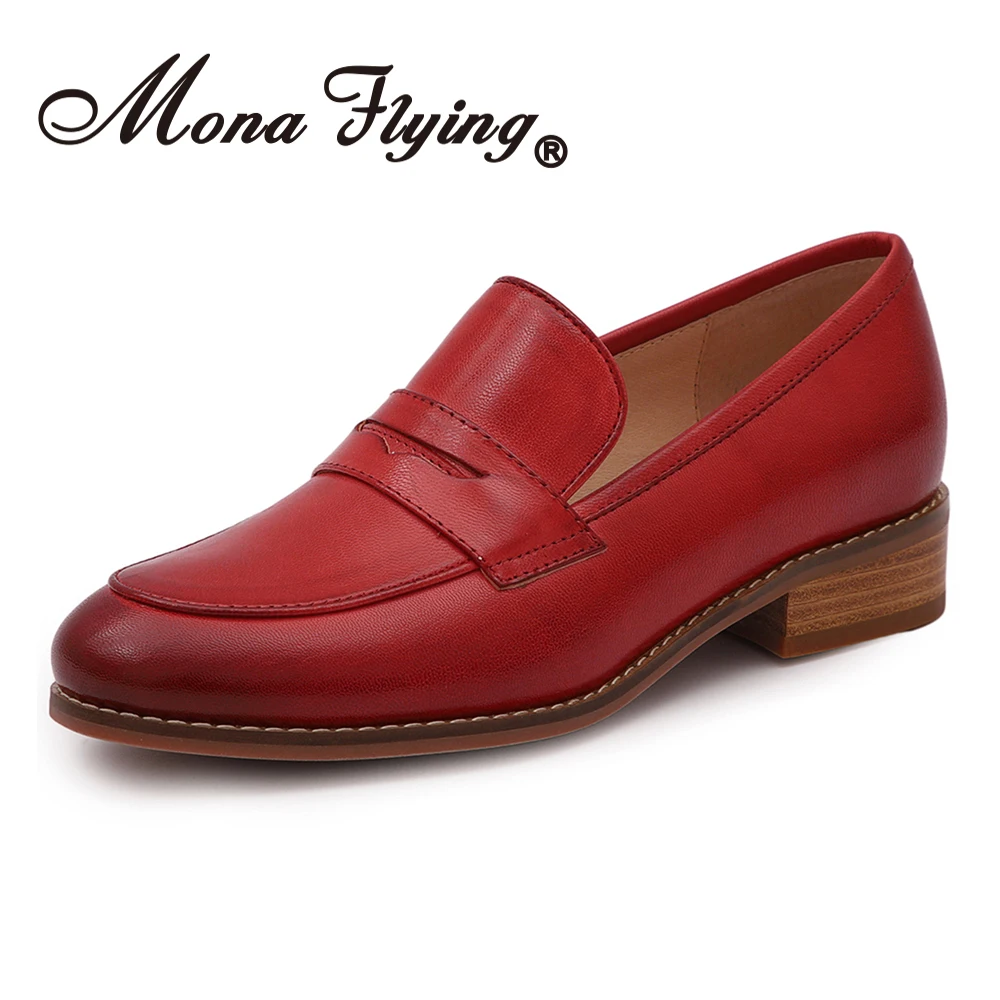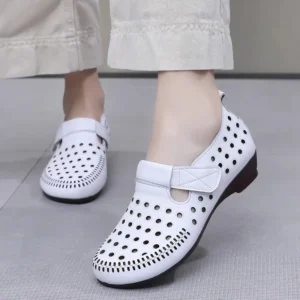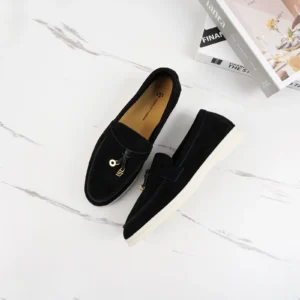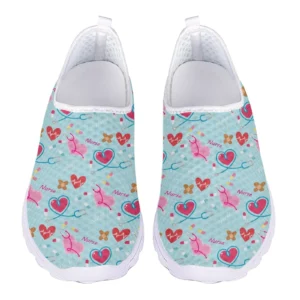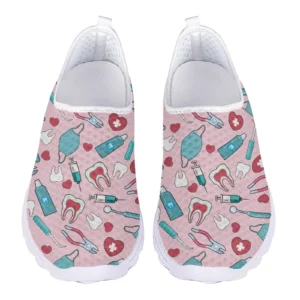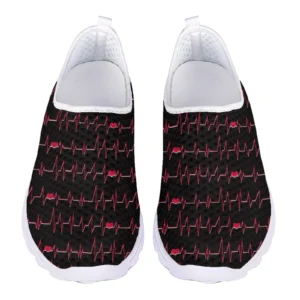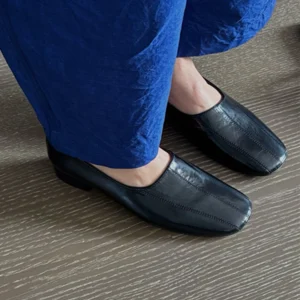Introduction
Proper leather loafer care is more than just keeping shoes clean—it’s about preserving an investment, extending their lifespan, and maintaining that polished appearance that makes them so versatile and timeless. High-quality leather loafers represent both financial and stylistic investments that can last for years or even decades when properly maintained.
Regular cleaning prevents leather from drying out, cracking, and losing its natural suppleness while preserving the rich color and texture that make leather loafers so desirable. In this comprehensive guide, you’ll learn the step-by-step process for cleaning different types of leather loafers, from everyday maintenance to tackling stubborn stains and scuffs. Understanding the fundamental principles of leather vs. suede loafer care helps ensure you’re using the right techniques without damaging your precious footwear.
Understanding Your Leather Loafers
Before diving into cleaning, it’s essential to identify exactly what type of leather your loafers are made from, as different leather types require specific cleaning approaches. Using the wrong cleaning method could damage your footwear permanently.
Common leather types found in loafers include:
- Smooth/Full-grain leather – The most common type, with a natural surface that shows the hide’s original texture and pores
- Patent leather – Features a high-gloss, sealed finish that’s more resistant to stains but requires gentle cleaning
- Suede/Nubuck – Has a fuzzy, velvety surface that requires specialized cleaning techniques
When assessing your loafers, examine how soiled they are—light surface dust requires minimal intervention, while deep stains or embedded dirt demand more thorough cleaning. For specialized materials like suede, understanding proper care guide for suede loafers is crucial to avoid irreparable damage.
Always check for any manufacturer care instructions that came with your loafers, as these often provide specific recommendations for that particular leather type and finish.
Essential Supplies for Cleaning Leather Loafers
Using the right tools and products makes all the difference between damaging your leather loafers and restoring them to their former glory. Having a complete leather care kit ensures you’ll be prepared for regular maintenance and more intensive cleaning situations.
Here’s what you’ll need:
- Shoe trees (preferably cedar) – Maintain the shape of loafers during cleaning and drying
- Soft horsehair brush – Gently removes surface dust without scratching leather
- Microfiber cloths – Non-abrasive for applying products and buffing
- Leather cleaner (pH-neutral) – Specifically formulated to clean without drying out leather
- Leather conditioner – Restores moisture and prevents drying/cracking
- Small bowl with lukewarm water – For diluting cleaners when necessary
- Cotton swabs or soft toothbrush – For reaching crevices and detailed areas
Optional but beneficial supplies:
* Saddle soap – For deeper cleaning of heavily soiled leather
* Leather cream/polish – Restores color and adds shine
* Protective spray – Creates barrier against moisture and stains
Natural bristle brushes are preferable as synthetic bristles can sometimes scratch delicate leather surfaces. Similarly, pH-neutral cleaners help maintain leather’s natural properties without causing color loss. For specific product recommendations suited to different leather types, explore our guide to the best products for loafer care.
Preparation: Before You Start Cleaning
Proper preparation prevents potential problems and ensures the best possible results when cleaning your leather loafers. Follow these steps before applying any cleaning products:
Insert shoe trees to maintain the proper shape during cleaning and drying. Cedar shoe trees are ideal as they also absorb moisture and odors.
Remove laces (if your loafer style has them) and clean them separately. This allows better access to all areas of the shoe and prevents cleaning products from damaging laces.
Remove loose dirt and dust using a soft horsehair brush. Brush gently in one direction rather than back and forth, which can push dirt particles deeper into the leather.
Perform a spot test with any cleaning products on an inconspicuous area, such as the inside heel or tongue. Wait 15-20 minutes to ensure there’s no discoloration or adverse reaction.
Create a proper workspace with good lighting and a clean, flat surface. Place a towel underneath your work area to catch any drips or spills.
These preparatory steps are particularly important for premium footwear like our women’s leather flat loafers to ensure the cleaning process enhances rather than diminishes their quality.
Step-by-Step Leather Loafer Cleaning Process
Once you’ve prepared your loafers and gathered supplies, follow this detailed process for a thorough cleaning:
Apply leather cleaner correctly
* Dampen a microfiber cloth slightly—it should feel damp to the touch but not wet enough to drip
* Apply a small amount of leather cleaner to the cloth, never directly to the leather
* Using small circular motions, gently work the cleaner into the leather, focusing on soiled areas first
* Wipe away excess cleaner with a clean section of the cloth or a separate damp clothClean crevices and hard-to-reach areas
* Dip a cotton swab or soft toothbrush in diluted leather cleaner
* Carefully clean along seams, around hardware, and in textured areas
* Pay special attention to tassels, stitching, and welts where dirt easily accumulates
* Wipe away residue with a slightly damp clothAddress scuffs and surface marks
* For light scuffs, often the leather cleaner will be sufficient
* For moderate scuffs, apply a small amount of leather conditioner to a cloth and rub gently
* Use circular motions that gradually decrease in pressure
* For persistent scuffs, a specialized leather scuff remover may be necessaryWipe down entire surface
* Using a clean, slightly damp cloth, wipe the entire loafer to remove any remaining cleaning solution
* Check for missed spots, especially around the heel and toe areas
* Ensure all cleaning product is removed to prevent residue build-up
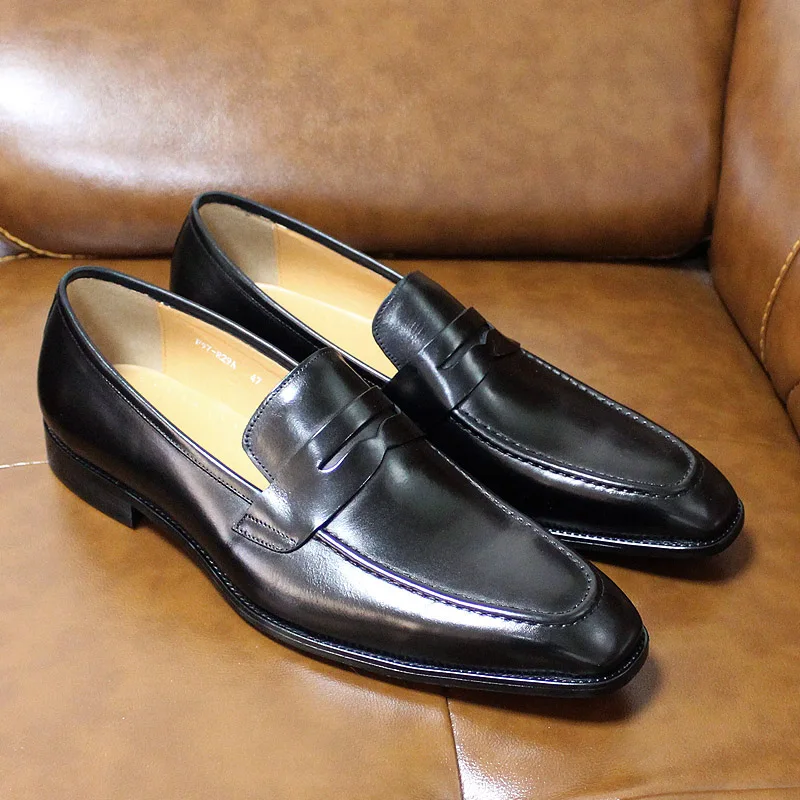
Proper Drying Techniques
How you dry your leather loafers after cleaning is just as important as the cleaning itself. Improper drying can lead to warping, cracking, and permanent damage.
Always allow leather loafers to dry naturally at room temperature. Never place them near direct heat sources like radiators, hair dryers, or in direct sunlight, as intense heat causes leather to dry out rapidly and crack.
Keep shoe trees inserted throughout the drying process to maintain shape. If your loafers became particularly damp during cleaning, stuff them with plain white paper (not newspaper, which can transfer ink) to help absorb moisture.
The drying process typically takes several hours to overnight, depending on how damp the loafers became during cleaning. Be patient—rushing this step by applying heat will compromise the leather quality. You’ll know your loafers are sufficiently dry when they return to their normal color and no longer feel cool to the touch.
Conditioning Your Leather Loafers
Conditioning is perhaps the most crucial step after cleaning, as it replaces essential oils and moisture removed during the cleaning process. Regular conditioning keeps leather supple, prevents cracking, and extends the life of your loafers.
Selecting the right conditioner for your specific leather type is important. Full-grain leather benefits from rich conditioners, while lighter formulas work better for finished leathers.
To condition properly:
- Apply a small amount of conditioner (about the size of a dime) to a clean, soft cloth
- Work the conditioner into the leather using gentle circular motions
- Pay extra attention to creased areas where the leather flexes during walking
- Allow the conditioner to absorb for 10-20 minutes
- Buff away any excess with a clean cloth until the leather no longer feels tacky
Properly conditioned leather should feel soft and supple but not greasy. The leather may darken slightly when first conditioned, but it typically returns to its original color as it dries. For comprehensive approaches to maintaining your leather footwear beyond basic cleaning, explore our guide on long-term leather footwear care.
Polishing for a Professional Finish (Optional)
While not always necessary, polishing adds a professional finish that enhances both appearance and protection. This step is particularly beneficial for loafers worn in professional settings or when you want to restore a rich shine.
Choose between:
* Cream polish – Adds moderate shine while conditioning and restoring color
* Wax polish – Creates a higher shine and provides additional water resistance
When selecting polish color, match it closely to your loafers or choose a neutral shade for safe results. Slightly darker polish can restore color to faded areas, but test in an inconspicuous spot first.
For optimal results:
1. Apply a thin, even layer of polish with a soft cloth
2. Use small circular motions, covering the entire surface
3. Allow to dry for 10-15 minutes until it develops a slight haze
4. Buff vigorously with a clean cloth or horsehair brush until you achieve your desired shine level
Polishing is particularly important for maintaining the classic appearance of traditional styles like our women’s classic penny loafers.
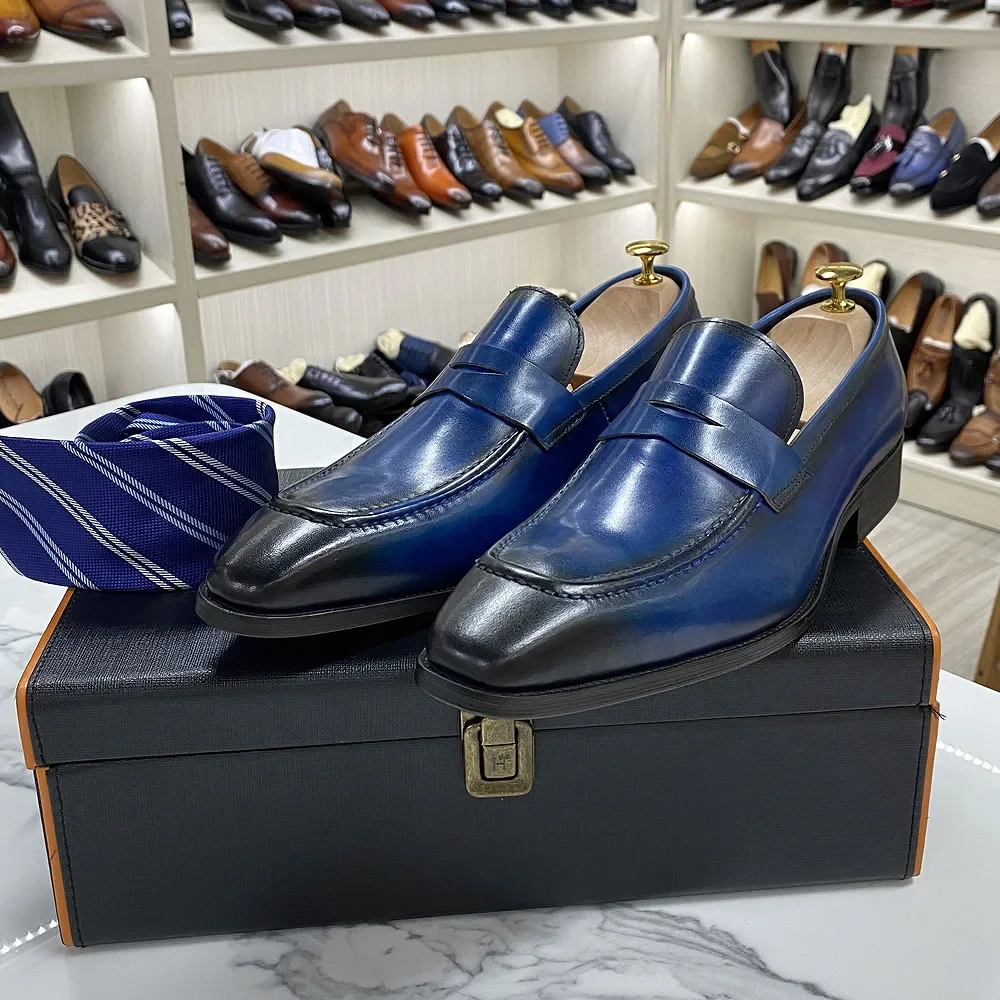
Applying Protective Treatment
A quality protective treatment creates an invisible barrier that repels water, prevents staining, and minimizes damage from everyday wear. This final step significantly extends the time between deep cleanings.
Different protective options include:
* Water-repellent sprays – Lightweight protection that allows leather to breathe
* Cream protectants – Provide protection while adding conditioning benefits
* Wax-based protectants – Offer maximum protection but may affect breathability
For proper application:
1. Hold spray protectants 6-8 inches away from the leather surface
2. Apply in light, even coats rather than one heavy application
3. Ensure complete coverage, including seams and creases
4. Allow to dry completely between coats (typically 30 minutes)
5. Let the final coat cure fully before wearing (usually 24 hours)
Protection should be reapplied every 2-3 months with regular wear, or more frequently in harsh weather conditions. Our women’s leather penny loafers benefit greatly from regular protective treatment, especially when worn in varying weather conditions.
Addressing Common Leather Loafer Problems
Even with regular care, leather loafers sometimes develop specific issues that require targeted solutions. Here’s how to address the most common problems:
Water Stains
* Blot excess water immediately if loafers get wet
* For dried water stains, dampen a cloth with distilled water and gently blot the entire panel (not just the stain)
* Allow to dry completely, then condition
* Prevention: Apply water-resistant protectant regularly
Salt Stains
* Mix equal parts white vinegar and water
* Gently dab solution on salt stains with a soft cloth
* Wipe clean with a damp cloth to remove vinegar solution
* Condition thoroughly after treatment to restore pH balance
Scuffs and Scratches
* For light scuffs, rub gently with your finger (natural oils can help)
* Apply leather conditioner to the area and buff
* For deeper scratches, use a matching color cream polish
* Severe scratches may require leather filler products
Oil and Grease Stains
* Blot (don’t rub) fresh stains immediately
* Sprinkle cornstarch or talcum powder to absorb oil
* Let sit overnight, then brush away
* Repeat as necessary before cleaning normally
* Deep-set oil stains may require professional attention
Interior Odor
* Insert cedar shoe trees between wears
* Sprinkle baking soda inside, let sit overnight, then vacuum out
* Use specialized shoe deodorizing sprays for persistent odors
Understanding the differences between caring for various materials helps you choose the right approach—learn more about leather vs. suede maintenance guide for comprehensive material care.
Long-Term Care and Maintenance
Establishing a regular maintenance schedule prevents major issues and extends the life of your leather loafers significantly. Here’s a practical maintenance timeline:
Daily (After Each Wear)
* Wipe with a soft cloth to remove surface dust
* Insert cedar shoe trees to maintain shape and absorb moisture
* Allow 24 hours of rest between wears when possible
Weekly
* Light brushing to remove accumulated dust
* Check for scuffs or spots needing attention
* Wipe with a slightly damp cloth if needed
Monthly
* Apply conditioner to prevent drying and cracking
* Check for signs of wear on soles and heels
* Touch up minor scuffs and marks
Seasonally (Every 3-4 Months)
* Deep clean using the complete process
* Reapply protective treatment
* Assess for any repairs needed
Proper storage is equally important—keep loafers in a cool, dry place away from direct sunlight and heat sources. Use dust bags when storing for extended periods and maintain consistent shape with shoe trees. Understanding how wear leather loafers casually affects their maintenance needs helps you adjust your care routine appropriately.
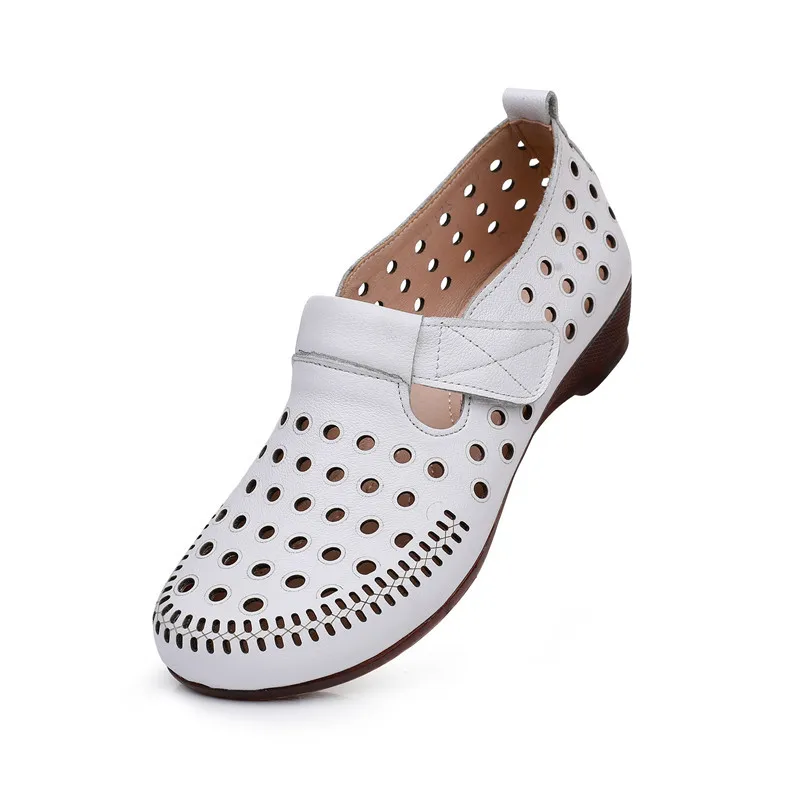
Common Mistakes to Avoid When Cleaning Leather Loafers
Even with good intentions, these common mistakes can damage your leather loafers:
Using harsh household cleaners – Products like dish soap, all-purpose cleaners, or alcohol can strip natural oils and damage leather finishes
Oversaturating with water or products – Excess moisture can penetrate leather, causing warping, discoloration, and structural damage
Drying with direct heat – Hairdryers, heaters, or direct sunlight causes leather to dry too quickly, leading to cracking and stiffness
Skipping conditioning after cleaning – Cleaning removes natural oils that must be replaced to maintain leather’s suppleness
Applying excessive product – More is not better; too much polish, conditioner, or protectant creates build-up and attracts dirt
Aggressive scrubbing or brushing – Harsh motions can damage leather fibers and finish; always use gentle circular motions
Using silicone-based products – While they provide temporary shine, silicone can build up over time, preventing leather from breathing
Ignoring manufacturer guidelines – Some specialty leathers require specific care products that override general advice
Insufficient drying time between steps – Rushing the process leads to trapped moisture and improper product absorption
Women's Comfortable Flat Loafers, Women's Leather Flat Loafers, Women's Round Toe Flat Loafers
$124.88 Select options This product has multiple variants. The options may be chosen on the product pageWomen's Loafer Mules, Women's Suede Flat Loafers
$190.23 Select options This product has multiple variants. The options may be chosen on the product pageWomen's Classic Driving Loafers, Women's Classic Penny Loafers, Women's Comfortable Flat Loafers
$75.28 Select options This product has multiple variants. The options may be chosen on the product pageWomen's Black Flat Loafers, Women's Classic Penny Loafers, Women's Comfortable Flat Loafers
$75.28 Select options This product has multiple variants. The options may be chosen on the product pageWomen's Classic Penny Loafers, Women's Comfortable Flat Loafers
$92.49 Select options This product has multiple variants. The options may be chosen on the product pageWomen's Block Heel Loafers, Women's Leather Flat Loafers, Women's Leather Penny Loafers
$295.19 Select options This product has multiple variants. The options may be chosen on the product page
When to Seek Professional Help
While many leather issues can be addressed at home, some situations call for professional expertise. Consider professional leather care when dealing with:
- Deep-set stains like ink, dye transfers, or paint that haven’t responded to home treatments
- Significant structural damage such as deep cuts, tears, or separated soles
- Color restoration for severely faded or discolored leather
- Specialized leather types with unique finishes or treatments
When seeking professional help, look for specialists with specific experience in leather footwear rather than general dry cleaners. A qualified cobbler or leather care specialist will have the tools, products, and expertise to address serious issues without causing further damage.
Before entrusting your loafers to a professional, ask about their experience with your specific leather type and the techniques they’ll use. Quality professional leather cleaning typically costs between $25-75 depending on the issue’s severity and treatment required. For valuable or specialized footwear like our women’s suede flat loafers, professional maintenance can be a worthwhile investment.
How Often Should You Clean Your Leather Loafers?
The ideal cleaning frequency depends on several factors specific to your situation. For most people, a light cleaning (dusting and spot-treating) should happen weekly, while deep cleaning with conditioning is appropriate every 2-3 months for regularly worn loafers.
However, this schedule should be adjusted based on:
- Wear frequency – Daily worn loafers need more frequent care than occasional pairs
- Environmental conditions – Urban environments with pollution and grime require more frequent cleaning
- Weather exposure – Wet or snowy conditions necessitate more immediate and frequent care
- Storage quality – Well-stored loafers generally need less frequent cleaning
Visual and tactile indicators that cleaning is needed include visible dirt buildup, dull appearance, stiff leather feel, or visible water spots. The key is finding balance—over-cleaning can strip natural oils and damage leather, while neglect leads to permanent staining and deterioration.
Can You Use Household Products to Clean Leather Loafers?
While specialized leather care products are always preferable, certain household items can work in emergencies. However, proceed with caution, as improper substitutes can damage leather permanently.
In a pinch, you might use:
- Mild, unscented soap (like Dove or Ivory) diluted with water (1:8 ratio)
- Plain water for light cleaning, followed immediately by thorough drying
- White vinegar solution (1:1 with water) specifically for salt stains
Always avoid:
* Dish soap, detergents, or cleaning products with degreasers
* Alcohol-based products including hand sanitizer
* Bleach or ammonia-based cleaners
* Furniture polish or oils
If you must use household products, apply minimally and follow up with proper leather conditioner as soon as possible. The potential risk to valuable loafers generally outweighs the convenience of household substitutes, so investing in proper leather care products is strongly recommended for long-term footwear maintenance.
Frequently Asked Questions
How to clean the inside of leather loafers?
To clean loafer interiors, remove insoles if possible and lightly spray with a fabric-safe disinfectant spray. For odor control, sprinkle baking soda inside, let sit overnight, then vacuum out. Wipe inside surfaces with a cloth dampened with equal parts water and white vinegar, then allow to thoroughly dry away from direct heat.
Can leather loafers be washed in washing machines?
No, never machine wash leather loafers. The water saturation, agitation, and detergents will damage leather, potentially causing irreparable harm through cracking, warping, and color loss. Always clean leather loafers by hand using appropriate leather-specific products.
How to restore color to faded leather loafers?
Restore faded leather by first cleaning thoroughly, then applying a color-matched leather cream or polish. For significant fading, consider a leather dye kit designed for shoes, followed by proper conditioning and protecting. Test any color product on an inconspicuous area first.
What to do if leather loafers get completely soaked?
For soaked loafers, blot excess moisture with absorbent towels, insert shoe trees or stuff with plain paper (not newspaper), and allow to dry naturally at room temperature away from heat sources. Once dry, clean as needed and apply conditioner to restore moisture balance.
Are waterproof sprays safe for all leather loafers?
Not all protective sprays work for all leather types. Water-based protectants are generally safest for most leathers, while silicone and heavy wax formulations may affect breathability or finish. Always check product compatibility with your specific leather type and test on an inconspicuous area first. For comprehensive guidance on all aspects of leather and suede maintenance, explore our complete guide to leather suede care.
How to store leather loafers during off-seasons?
For seasonal storage, clean and condition loafers thoroughly, insert cedar shoe trees to maintain shape, and place in breathable dust bags or pillowcases. Store in a cool, dry location away from direct sunlight. Periodically check for mold or pest issues during extended storage periods.

